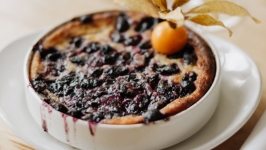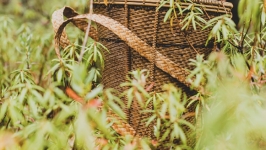Sweet 'n' Tart
When our best chefs compete in the Canadian Culinary Championships, they are handed a black box of ingredients to use in turning out their palatepleasing productions. In early February’s competition at Algonquin College in Ottawa, there was a curious-looking berry inside that not every chef could even identify. Surprising? Not really. For those delicious berries are newcomers to the Canadian palate, though they promise to become very popular in only a few years.
Haskaps, those long, knobbly, dark-coloured berries otherwise known as honeyberries, blue honeysuckle or, for the scientifically literate, Lonicera caerulea, originate from Japan. However, under a program at the University of Saskatchewan begun in the 1990s by Dr. Bob Bors, they have been meticulously researched and cultivated. Now, all nine major haskap varieties in Canada — including Borealis, Indigo Gem and Tundra — were bred in this program at the University.
Doris and Axel Huidberg, owners of High Mountain Farm in Salmon Arm, have come up with an ingenious way to maximize profits from their haskap crop. First, they sell their deliciously tangy fruit to Okanagan Spirits, where they are made into a haskap berry liquor. Those booze-laden berries are then resold to the restaurant industry to make sauces and reductions.
The Huidbergs also make liquor chocolates from those infused berries, as well as selling haskap berry compote in glass mason jars — not to mention selling fresh berries straight from the farm gate.
Most people describe the taste as a mix between raspberries, blackberries and blueberries. However described, it’s hard to dislike, as Axel notes. “Fresh off the bush, they are unbelievably good. Children love the taste of haskap because it has that little bit of tang at the end — it's like nature’s candy for kids. During fresh berry season, we see families pick up a pint container of haskaps and the kids have eaten them all before they even get out of the parking lot.”
Axel and Doris Huidberg came to farming after careers in industry and commercial aviation, respectively. Axel was thinking of buying a small hobby farm when Doris “blindsided” him with a 13-acre property on a stunning spot in Salmon Arm, BC.
Instead of the 10-by-12-foot greenhouses he expected to manage, they ended up with two large 30-by-65-foot spaces. All they needed was a crop to grow. After chatting with a friend in 2011, they were introduced to this little known berry and amazed at how easily it thrived.
“Haskap is tough. The plant itself is cold hardy to -47C and the blooms are frost tolerant to minus eight. It’s the very first crop to bloom, one of the first flowers out there, so the first source of food for any bumblebees and other pollinating insects,” Axel says.
The haskap plant is so easy to grow that Axel calls them “the perfect lazy farmer’s plant.”
Although that first crop grew well, they initially thought their investment in haskaps was a blunder. When Axel saw the first berry, he called out excitedly for Doris to come and try it.
Doris picks up the story, “I ate it and then I promptly spit it out. I looked at Axel and said, ‘I think we made a mistake — these things are horrible!’ It wasn’t ripe. A week later, I tried it again – and they were absolutely delicious,” she says, laughing.
Those first berries were enjoyed in 2012 and the couple has acted as spokespeople for the berry ever since. “We became pioneers in the industry within the province of British Columbia,” Axel says. Working closely with the University of Saskatchewan, the pair did a couple of grower’s seminars to get other farmers interested, helped put in over 250 acres of haskap berries throughout British Columbia, the Yukon and Alberta, and now offer consulting services on growing haskap.
Their promotion of the berry included working with the British Columbia Haskap Association (BCHA). For the first few years, Axel served as president with Doris as secretary. The association now has a new board of directors and a membership of more than 60 farms.
The couple also took part in many events to raise public awareness and appreciation for haskap berries, including the Every Chef Needs a Farmer, Every Farmer Needs a Chef event. This annual province-wide day brings farmers and chefs together to highlight and promote BC produce. It’s there that the Huidbergs from High Mountain Farm first met Chef Welbert Choi.
After moving to North Burnaby as a teenager, Chef Choi trained at Dubrulle Culinary Institute. He now holds the title of Executive Chef at Forage, Timber and Forage Catering. He understands the importance of building relationships with local producers and had already tried High Mountain Farm berries before he met the owners. “Axel and Doris are very passionate about haskaps and are able to produce such a superior product,” he says.
Choi says that haskaps are very versatile for cooking due to their low sugar content and pair well with both sweet and savoury dishes. He particularly loves haskaps with duck. “The mix with port wine gives a little sour finish which brings out the duck flavour even more. Really, to have such a hearty plant full of nutritional value tolerant to -47C is a perfect example of agriculture sustainability and food security in BC,” he says.
As much as Doris and Axel enjoy the berries on their own, they also enjoy the haskap in the compote they make and sell — particularly as a topping on French vanilla ice cream.
Doris finds a winner in the haskap berry liquor, but the berries are irresistible even when merely freeze-dried. “I have to lock them up or I would eat them all like candy,” she says.
High Mountain Farm
1630 51 St. N.E., Salmon Arm, BC
haskapbc.com | 250.803.8203
In Kelowna, Lana and Ross Nunweiler (pictured below) have been growing haskap berries on their farm, Honeyberry Acres. Honeyberry is another term for haskaps that, Lana believes, has a nicer sound to it. Their plot of two and a half acres supports an acre of honeyberries, with blueberries, raspberries and vegetables, all certified organic, making up the balance.
Their organic produce, including the honeyberries, supplies local restaurants and is also sold from the farm gate, with pre-orders accepted on their website.
Lana says she stumbled upon haskaps when researching suitable crops for their new land in the Okanagan, after they’d sold the flower farm they had spent the previous 30 years running in Saskatchewan. Ross had a background in the food industry, so had heard of the berries. For Lana, they were a new find — delicious, but certainly strange looking. “
They are very unusual looking,” she says. “Every variety is a slightly different shape; they have the colour of a blueberry, but they’re more elongated; some are twisty wiggly, some are more oval, some are slightly heart-shaped; each one is different, not uniform like a raspberry or blueberry.”
One of the first things that struck Lana about her haskaps was the intense colour of the berry and the juice produced, which can stain your hands. “The colour is unbelievably rich. The interesting thing about the berry is that, when it grows, it has two beautiful little yellow flowers that sort of teardrop and start forming the blue skin and then one skin forms around the two of them. I don’t know if that’s why they are so much bluer when you squeeze out the colour.”
Haskaps, often called a superfood, have an incredible nutritional profile. They are naturally high in antioxidants, in fact, much higher than other fruits, and contain vitamins A and C, magnesium, fibre and potassium.
“The nutritional value is really great and that ticked a box for us when we were researching what to grow,” Lana says. “They are a chart-topper for antioxidants.”
Lana can’t remember anybody not liking the taste of the haskap or honeyberry. In her description, it combines the texture of a blueberry and a taste somewhere between a raspberry and a saskatoon berry. Depending on the varietal, that taste can range from tart tanginess to very sweet.
Lana and Ross often eat them frozen as a snack. “We freeze them individually and then bag them up frozen, and so all winter long we have a supply. You can take a scoop and every berry is loose and frozen and they’re actually delicious to eat just like that.”
Lana also used them in her holiday turkey stuffing instead of cranberries and finds they make a great healthy addition to smoothies. But perhaps the most delicious way they can be enjoyed, aside from fresh from the bush, is in the Honeyberry Acres flavour gelato made by local Kelowna QB Gelato.
Lana says that growing and selling such a relatively unknown fruit has been an education for her and her customers. Every year, Honeyberry Acres is introducing more and more people to this delicious berry, a process she describes as “a very interesting adventure, for sure.”
Honeyberry Acres
4535 McCulloch Rd., Kelowna, BC
honeyberryacres.com | 250.212.9876













